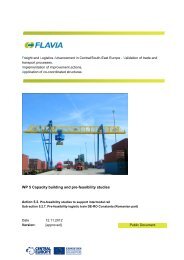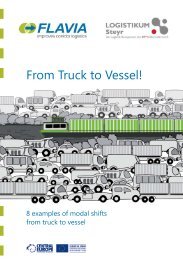SWOT-Analysis - FLAVIA
SWOT-Analysis - FLAVIA
SWOT-Analysis - FLAVIA
Create successful ePaper yourself
Turn your PDF publications into a flip-book with our unique Google optimized e-Paper software.
1 Executive Summary<br />
Freight and Logistics Advancement in Central/South-<br />
East Europe - Validation of trade and transport processes,<br />
Implementation of improvement actions, Application<br />
of coordinated structures<br />
The TRACECA corridor becomes more and more a strategic factor for the EU. In the last decade<br />
over 60 technical assistance and 14 investments projects were financed. The investment<br />
volume amounts to 170 mln €. Focussed issues are secure and safe transport, harmonizing<br />
legal regulations, facilitating trade and institutional support. The main aim for both – the EU and<br />
TRACECA – is to establish stable and continuous trade and transport relations. Also the transport<br />
operators and logistics providers invest more and more within the TRACECA region. The<br />
ports of Constanta, Odessa and Poti are already in the property of foreign transport companies.<br />
The present report delivers an assessment of the current trade and transport situation within the<br />
TRACECA region and its relations and links to the EU. Benefiting and hindering factors are assembled<br />
with the help of a <strong>SWOT</strong>-analysis. With the help of an own survey, results from other<br />
<strong>FLAVIA</strong> reports as well as experiences from other projects for all four fields concrete statements<br />
were prepared.<br />
The analysis shows that on paper the TRACECA region has a powerful position. The corridor is<br />
rich of natural deposits like oil, gas and strategic minerals (e.g. gold, seldom minerals and uranium).<br />
Furthermore, situated at the linkage point between Europe and Asia it possesses a growing<br />
relevance for international transport routes following the former Great Silk Road. The reactivation<br />
and expansion of the land bridge route could mean a serious alternative for the maritime<br />
route.<br />
Several pipeline projects are realised at the moment. They should supply Europe with gas for its<br />
energy production and should decrease the dependencies from Russian supplies. This might<br />
lead to conflicts in future.<br />
Despite of the existing resources and the large development potential the TRACECA region<br />
struggles with various problems which hamper the trade and transport relations. An unstable<br />
political environment accompanied with abuse of authority, corruption and organised crime disadvantage<br />
a large part of the region. All these factors scare potential investors.<br />
The infrastructure does not reach a Western standard. Especially the Eastern part of the<br />
TRACECA corridor needs new investments into the transport network. In addition the organisation<br />
of the transports has to be optimised. Long-lasting border procedure, unsafe transport conditions<br />
and missing services have to be overcome.<br />
A promising approach is a close cooperation between the EU and the TRACECA. A linkage of<br />
both regions with the help of common working groups or platforms could be one opportunity.<br />
The coordination of joint infrastructure projects for instance would avoid solo runs. The experiences<br />
from the TEN-T (Trans-European Transport Network) shaping process might be used for<br />
the creation of a “TCAN-T” (Trans-Central Asia Transport Network). Such a network could be<br />
the basis for further agreed expansions of the transport routes.<br />
- 4 -




